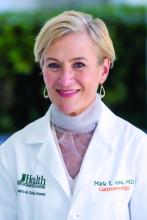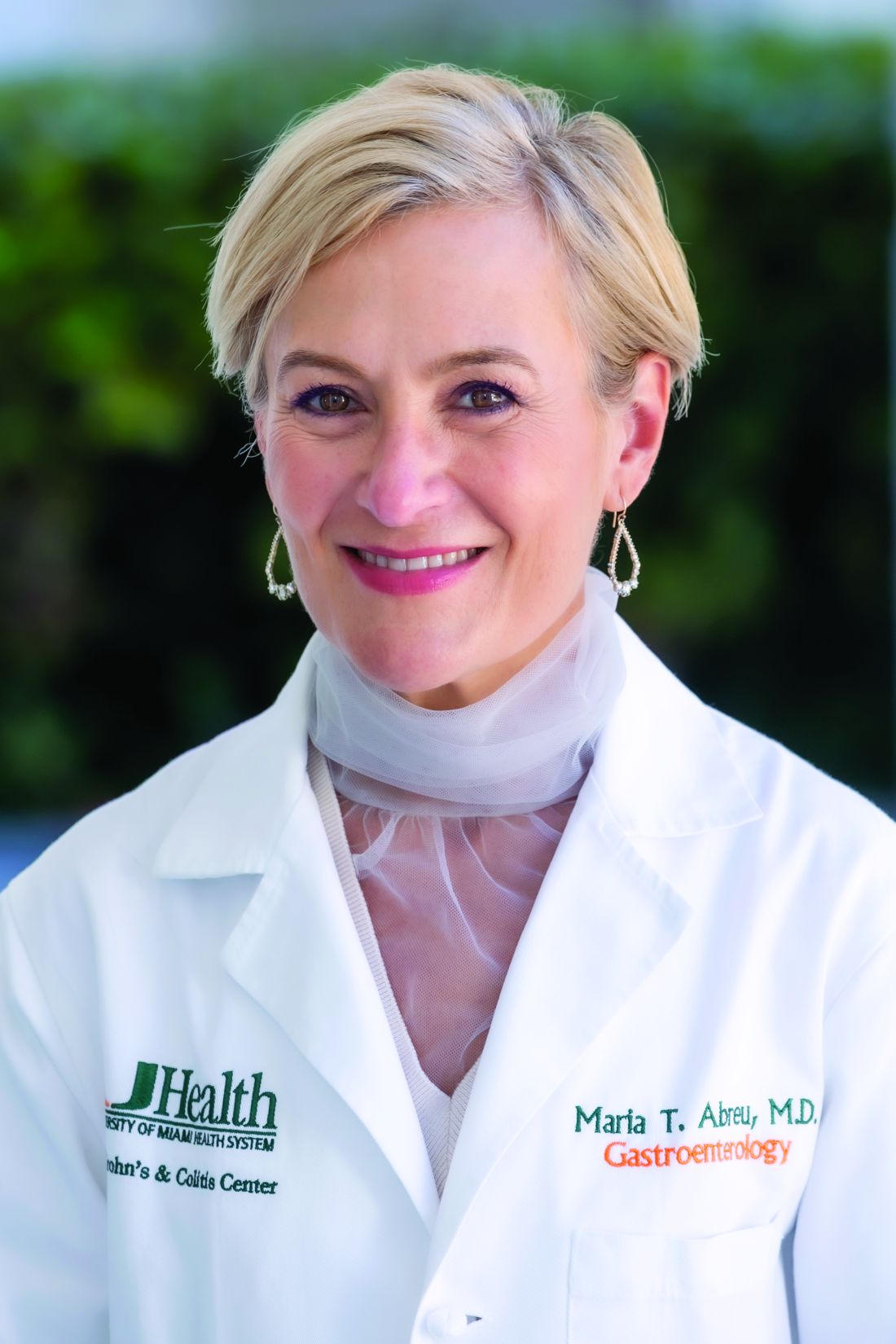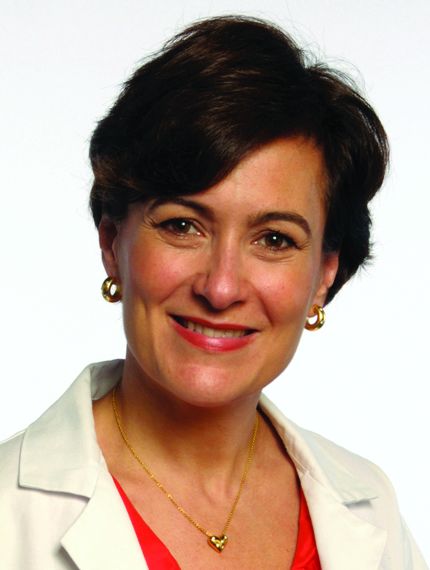User login
Noteworthy advances in treatment and management of IBD
Although it had been thought that incidence rates of IBD were plateauing in high-incidence areas, a Danish study found a steady increase in incidence of Crohn’s disease and ulcerative colitis (UC).1 The highest increase in rates occurred in children and young adults, which will have repercussions as people get older and contribute to higher compounding prevalence. We need to get better at dealing with other health conditions as patients get older. A very large prospective Spanish study found that 42% of IBD patients scanned consecutively had MAFLD (metabolic-associated fatty liver disease) – even if they didn’t have high BMI and type 2 diabetes, suggesting that systemic inflammation in IBD contributes to the development of metabolic liver disease.2
The AGA has recently published guidelines for using biomarkers in the management of UC. Patients with very low fecal calprotectin (FCP) are unlikely to have active disease whereas FCP over 150 with significant symptoms may warrant empiric changes in treatment.3
Intestinal ultrasound is gaining wider acceptance as a noninvasive way to monitor IBD.4 In a UC study, improvement in bowel wall thickness following tofacitinib treatment correlated well with endoscopic activity.5
The majority of the presentation focused on the explosion of Food and Drug Administration–-approved medications for IBD in recent years. S1P receptor agonists, such as ozanimod and etrasimod, may work by trapping specific T-cell subsets in peripheral lymph nodes, preventing migration to intestinal tissues. Ozanimod is approved for UC. Etrasimod showed efficacy in UC with clinical remission rates of about 27% at week 12 and 32% at week 52.6,7
There has been a lot of excitement about JAK inhibitors for IBD. Upadacitinib has recently been approved for both UC and Crohn’s disease. Response rates of 73% and remission rates of 26% were seen in UC patients who had been largely biologic exposed.8 Similar results were seen in a biologic-exposed Crohn’s disease population treated with upadacitinib including in endoscopy.9 Upadacitinib was effective in maintaining remission at both 15-mg and 30-mg doses; but the higher dose had a greater effect on endoscopic endpoints.10
For Crohn’s disease, we now have risankizumab, an anti-p19/IL-23 inhibitor. Risankizumab was efficacious at inducing and maintain remission in the pivotal phase 3 studies, even with 75% of patients being biologic exposed. These studies used combined endpoints of clinical remission as well as endoscopic response.11 Guselkumab (anti-p19/IL-23) is also being studied for Crohn’s disease and early trials has appears to be efficacious.12
A head-to-head study of naive CD patients treated with ustekinumab or adalimumab (SEAVUE) showed comparable rates of clinical remission. At 52 weeks, the rates of clinical remission were quite high: >60% and endoscopic remission >30% with either therapy.13
We now have phase 3 data showing that a biologic is efficacious in patients with chronic pouchitis. The EARNEST trial demonstrated that vedolizumab has efficacy in treating pouchitis with improved clinical symptoms and endoscopy.14 Future treatment strategies may involve combinations of biologic therapies. The VEGA study showed that combining an anti-TNF, golimumab, with an anti-IL23, guselkumab, was superior than either alone with respect to clinical remission and endoscopic improvement in UC.15 We will see more studies combining therapies with diverse mechanisms of action.
In summary, there have been many noteworthy advances in treatment and management of IBD in the past year.
DDW is sponsored by the American Association for the Study of Liver Diseases (AASLD), the American Gastroenterological Association (AGA), the American Society for Gastrointestinal Endoscopy (ASGE) and The Society for Surgery of the Alimentary Tract (SSAT).
Dr. Abreu is director of the Crohn’s and Colitis Center and professor of medicine, microbiology, and immunology at the University of Miami. She is president-elect of AGA. Dr. Allegretti is director of the Crohn’s and Colitis Center and director of the fecal microbiota transplant program at Brigham and Women’s Hospital, Boston. She is associate professor of medicine at Harvard Medical School, Boston. Dr. Loftus is the Maxine and Jack Zarrow Family Professor of Gastroenterology, codirector of the advanced IBD fellowship in the division of gastroenterology and hepatology at Mayo Clinic, Rochester, Minn. Dr. Ungaro is associate professor of medicine at the Icahn School of Medicine at Mount Sinai, New York.
References
1. Agrawal M et al. Gastroenterology. 2022;163(6):1547-54.e5.
2. Rodriguez-Duque JC et al. Clin Gastroenterol Hepatol. 2023;21(2):406-14.e7.
3. Singh S, et al. Gastroenterology. 2023;164(3):344-72.
4. de Voogd F et al. Gastroenterology. 2022;163(6):1569-81.
5. Sandborn WJ et al. N Engl J Med. 2017;376(18):1723-36.
6. Sandborn WJ et al. N Engl J Med. 2021;385(14):1280-91.
7. Sandborn WJ et al. Lancet. 2023 Mar 25;401(10381):1000]. Lancet. 2023;401(10383):1159-71.
8. Danese S et al. Lancet. 2022 Sep 24;400(10357):996]. Lancet. 2022;399(10341):2113-28.
9. Loftus EV Jr et al. N Engl J Med. 2023 May 25;388(21):1966-80.
10. Panes J et al. Am J Gastroenterol 2022;117(S10). Abstract S37.
11. D’Haens G, et al. Lancet. 2022;399(10340):2015-30
12. Sandborn WJ et al. Gastroenterology. 2022;162(6):1650-64.e8.
13. Sands BE, et al. Lancet. 2022;399(10342):2200-11.
14. Travis S et al. N Engl J Med. 2023;388(13):1191-1200.
15. Feagan BG et al. Lancet Gastroenterol Hepatol. 2023;8(4):307-20.
Although it had been thought that incidence rates of IBD were plateauing in high-incidence areas, a Danish study found a steady increase in incidence of Crohn’s disease and ulcerative colitis (UC).1 The highest increase in rates occurred in children and young adults, which will have repercussions as people get older and contribute to higher compounding prevalence. We need to get better at dealing with other health conditions as patients get older. A very large prospective Spanish study found that 42% of IBD patients scanned consecutively had MAFLD (metabolic-associated fatty liver disease) – even if they didn’t have high BMI and type 2 diabetes, suggesting that systemic inflammation in IBD contributes to the development of metabolic liver disease.2
The AGA has recently published guidelines for using biomarkers in the management of UC. Patients with very low fecal calprotectin (FCP) are unlikely to have active disease whereas FCP over 150 with significant symptoms may warrant empiric changes in treatment.3
Intestinal ultrasound is gaining wider acceptance as a noninvasive way to monitor IBD.4 In a UC study, improvement in bowel wall thickness following tofacitinib treatment correlated well with endoscopic activity.5
The majority of the presentation focused on the explosion of Food and Drug Administration–-approved medications for IBD in recent years. S1P receptor agonists, such as ozanimod and etrasimod, may work by trapping specific T-cell subsets in peripheral lymph nodes, preventing migration to intestinal tissues. Ozanimod is approved for UC. Etrasimod showed efficacy in UC with clinical remission rates of about 27% at week 12 and 32% at week 52.6,7
There has been a lot of excitement about JAK inhibitors for IBD. Upadacitinib has recently been approved for both UC and Crohn’s disease. Response rates of 73% and remission rates of 26% were seen in UC patients who had been largely biologic exposed.8 Similar results were seen in a biologic-exposed Crohn’s disease population treated with upadacitinib including in endoscopy.9 Upadacitinib was effective in maintaining remission at both 15-mg and 30-mg doses; but the higher dose had a greater effect on endoscopic endpoints.10
For Crohn’s disease, we now have risankizumab, an anti-p19/IL-23 inhibitor. Risankizumab was efficacious at inducing and maintain remission in the pivotal phase 3 studies, even with 75% of patients being biologic exposed. These studies used combined endpoints of clinical remission as well as endoscopic response.11 Guselkumab (anti-p19/IL-23) is also being studied for Crohn’s disease and early trials has appears to be efficacious.12
A head-to-head study of naive CD patients treated with ustekinumab or adalimumab (SEAVUE) showed comparable rates of clinical remission. At 52 weeks, the rates of clinical remission were quite high: >60% and endoscopic remission >30% with either therapy.13
We now have phase 3 data showing that a biologic is efficacious in patients with chronic pouchitis. The EARNEST trial demonstrated that vedolizumab has efficacy in treating pouchitis with improved clinical symptoms and endoscopy.14 Future treatment strategies may involve combinations of biologic therapies. The VEGA study showed that combining an anti-TNF, golimumab, with an anti-IL23, guselkumab, was superior than either alone with respect to clinical remission and endoscopic improvement in UC.15 We will see more studies combining therapies with diverse mechanisms of action.
In summary, there have been many noteworthy advances in treatment and management of IBD in the past year.
DDW is sponsored by the American Association for the Study of Liver Diseases (AASLD), the American Gastroenterological Association (AGA), the American Society for Gastrointestinal Endoscopy (ASGE) and The Society for Surgery of the Alimentary Tract (SSAT).
Dr. Abreu is director of the Crohn’s and Colitis Center and professor of medicine, microbiology, and immunology at the University of Miami. She is president-elect of AGA. Dr. Allegretti is director of the Crohn’s and Colitis Center and director of the fecal microbiota transplant program at Brigham and Women’s Hospital, Boston. She is associate professor of medicine at Harvard Medical School, Boston. Dr. Loftus is the Maxine and Jack Zarrow Family Professor of Gastroenterology, codirector of the advanced IBD fellowship in the division of gastroenterology and hepatology at Mayo Clinic, Rochester, Minn. Dr. Ungaro is associate professor of medicine at the Icahn School of Medicine at Mount Sinai, New York.
References
1. Agrawal M et al. Gastroenterology. 2022;163(6):1547-54.e5.
2. Rodriguez-Duque JC et al. Clin Gastroenterol Hepatol. 2023;21(2):406-14.e7.
3. Singh S, et al. Gastroenterology. 2023;164(3):344-72.
4. de Voogd F et al. Gastroenterology. 2022;163(6):1569-81.
5. Sandborn WJ et al. N Engl J Med. 2017;376(18):1723-36.
6. Sandborn WJ et al. N Engl J Med. 2021;385(14):1280-91.
7. Sandborn WJ et al. Lancet. 2023 Mar 25;401(10381):1000]. Lancet. 2023;401(10383):1159-71.
8. Danese S et al. Lancet. 2022 Sep 24;400(10357):996]. Lancet. 2022;399(10341):2113-28.
9. Loftus EV Jr et al. N Engl J Med. 2023 May 25;388(21):1966-80.
10. Panes J et al. Am J Gastroenterol 2022;117(S10). Abstract S37.
11. D’Haens G, et al. Lancet. 2022;399(10340):2015-30
12. Sandborn WJ et al. Gastroenterology. 2022;162(6):1650-64.e8.
13. Sands BE, et al. Lancet. 2022;399(10342):2200-11.
14. Travis S et al. N Engl J Med. 2023;388(13):1191-1200.
15. Feagan BG et al. Lancet Gastroenterol Hepatol. 2023;8(4):307-20.
Although it had been thought that incidence rates of IBD were plateauing in high-incidence areas, a Danish study found a steady increase in incidence of Crohn’s disease and ulcerative colitis (UC).1 The highest increase in rates occurred in children and young adults, which will have repercussions as people get older and contribute to higher compounding prevalence. We need to get better at dealing with other health conditions as patients get older. A very large prospective Spanish study found that 42% of IBD patients scanned consecutively had MAFLD (metabolic-associated fatty liver disease) – even if they didn’t have high BMI and type 2 diabetes, suggesting that systemic inflammation in IBD contributes to the development of metabolic liver disease.2
The AGA has recently published guidelines for using biomarkers in the management of UC. Patients with very low fecal calprotectin (FCP) are unlikely to have active disease whereas FCP over 150 with significant symptoms may warrant empiric changes in treatment.3
Intestinal ultrasound is gaining wider acceptance as a noninvasive way to monitor IBD.4 In a UC study, improvement in bowel wall thickness following tofacitinib treatment correlated well with endoscopic activity.5
The majority of the presentation focused on the explosion of Food and Drug Administration–-approved medications for IBD in recent years. S1P receptor agonists, such as ozanimod and etrasimod, may work by trapping specific T-cell subsets in peripheral lymph nodes, preventing migration to intestinal tissues. Ozanimod is approved for UC. Etrasimod showed efficacy in UC with clinical remission rates of about 27% at week 12 and 32% at week 52.6,7
There has been a lot of excitement about JAK inhibitors for IBD. Upadacitinib has recently been approved for both UC and Crohn’s disease. Response rates of 73% and remission rates of 26% were seen in UC patients who had been largely biologic exposed.8 Similar results were seen in a biologic-exposed Crohn’s disease population treated with upadacitinib including in endoscopy.9 Upadacitinib was effective in maintaining remission at both 15-mg and 30-mg doses; but the higher dose had a greater effect on endoscopic endpoints.10
For Crohn’s disease, we now have risankizumab, an anti-p19/IL-23 inhibitor. Risankizumab was efficacious at inducing and maintain remission in the pivotal phase 3 studies, even with 75% of patients being biologic exposed. These studies used combined endpoints of clinical remission as well as endoscopic response.11 Guselkumab (anti-p19/IL-23) is also being studied for Crohn’s disease and early trials has appears to be efficacious.12
A head-to-head study of naive CD patients treated with ustekinumab or adalimumab (SEAVUE) showed comparable rates of clinical remission. At 52 weeks, the rates of clinical remission were quite high: >60% and endoscopic remission >30% with either therapy.13
We now have phase 3 data showing that a biologic is efficacious in patients with chronic pouchitis. The EARNEST trial demonstrated that vedolizumab has efficacy in treating pouchitis with improved clinical symptoms and endoscopy.14 Future treatment strategies may involve combinations of biologic therapies. The VEGA study showed that combining an anti-TNF, golimumab, with an anti-IL23, guselkumab, was superior than either alone with respect to clinical remission and endoscopic improvement in UC.15 We will see more studies combining therapies with diverse mechanisms of action.
In summary, there have been many noteworthy advances in treatment and management of IBD in the past year.
DDW is sponsored by the American Association for the Study of Liver Diseases (AASLD), the American Gastroenterological Association (AGA), the American Society for Gastrointestinal Endoscopy (ASGE) and The Society for Surgery of the Alimentary Tract (SSAT).
Dr. Abreu is director of the Crohn’s and Colitis Center and professor of medicine, microbiology, and immunology at the University of Miami. She is president-elect of AGA. Dr. Allegretti is director of the Crohn’s and Colitis Center and director of the fecal microbiota transplant program at Brigham and Women’s Hospital, Boston. She is associate professor of medicine at Harvard Medical School, Boston. Dr. Loftus is the Maxine and Jack Zarrow Family Professor of Gastroenterology, codirector of the advanced IBD fellowship in the division of gastroenterology and hepatology at Mayo Clinic, Rochester, Minn. Dr. Ungaro is associate professor of medicine at the Icahn School of Medicine at Mount Sinai, New York.
References
1. Agrawal M et al. Gastroenterology. 2022;163(6):1547-54.e5.
2. Rodriguez-Duque JC et al. Clin Gastroenterol Hepatol. 2023;21(2):406-14.e7.
3. Singh S, et al. Gastroenterology. 2023;164(3):344-72.
4. de Voogd F et al. Gastroenterology. 2022;163(6):1569-81.
5. Sandborn WJ et al. N Engl J Med. 2017;376(18):1723-36.
6. Sandborn WJ et al. N Engl J Med. 2021;385(14):1280-91.
7. Sandborn WJ et al. Lancet. 2023 Mar 25;401(10381):1000]. Lancet. 2023;401(10383):1159-71.
8. Danese S et al. Lancet. 2022 Sep 24;400(10357):996]. Lancet. 2022;399(10341):2113-28.
9. Loftus EV Jr et al. N Engl J Med. 2023 May 25;388(21):1966-80.
10. Panes J et al. Am J Gastroenterol 2022;117(S10). Abstract S37.
11. D’Haens G, et al. Lancet. 2022;399(10340):2015-30
12. Sandborn WJ et al. Gastroenterology. 2022;162(6):1650-64.e8.
13. Sands BE, et al. Lancet. 2022;399(10342):2200-11.
14. Travis S et al. N Engl J Med. 2023;388(13):1191-1200.
15. Feagan BG et al. Lancet Gastroenterol Hepatol. 2023;8(4):307-20.
AT DDW 2023
‘Game of Crohn’s ... and colitis’
Here is an update on the rapidly moving field of inflammatory bowel disease (IBD), from the power of the microbiome to the prediction of IBD and new ways to use established drugs.
Regarding the microbiome, we now understand that, while the healthy microbiome is diverse and able to produce short-chain fatty acids, such as butyrate, the dysbiotic IBD microbiome is less diverse and characterized by expansion of proinflammatory pathobionts (such as Fusobacterium), the proliferation of sulfate-reducing bacteria, and a decrease in anti-inflammatory butyrate production.
There have now been several promising trials of fecal microbial transplant (FMT) for the treatment of ulcerative colitis (UC). The most effective strategies have involved colonic delivery of FMT, pooled donors, and repeated stool enemas to solidify the response. Following FMT, patients’ microbial diversity increases. The hope is that we can use diet as a complement to maintain the diversity and generation of beneficial metabolites, as well as deliver the therapy orally.
Predicting IBD
Although we have made advances in therapy, we continue to miss opportunities to prevent long-term complications. At Digestive Disease Week,® Jean-Frederic Colombel, MD, a professor of medicine at the Icahn School of Medicine at Mount Sinai, New York, presented data on the PREDICTS study (Aliment Pharacol Ther. 2016 Jun;43[12]:1300-10), in which serum samples collected from military recruits prior to development of IBD was used to identify serologic markers that could predict those who ultimately developed Crohn’s disease but not UC.
The pediatric medical community, meanwhile, has studied an inception cohort of newly diagnosed, untreated children – the RISK cohort ( Lancet. 2017 Apr 29;389[10080]:1710-8 ) – to define some of the risk factors that predict more aggressive disease. By using biopsy tissue from the time of diagnosis, investigators could predict who would develop stricturing disease versus penetrating disease. Patients who would develop penetrating disease had up-regulation of inflammatory pathways and responded to anti–tumor necrosis factor therapy, while those who developed a stricturing phenotype had increased expression of extracellular matrix pathways and were significantly less likely to respond to anti-TNF therapy ( Lancet. 2017 Apr 29;389[10080]:1710-8 ). These studies provide a proof of concept that we might someday be able to use for personalized approaches to treating IBD.
Using new drugs, targeting new pathways
The recently published CALM study tested the hypothesis that treating to a target of no biochemical inflammation (elevated C reactive protein or fecal calprotectin) would be better than symptom-driven treatment alone. Treatment escalation for active disease included adalimumab every other week, then weekly adalimumab, and finally the addition of azathioprine. At the end of the study, patients whose medical therapy was based on both symptoms and biochemical inflammation had a higher degree of mucosal healing than did patients in the clinical management group (Lancet. 2018 Dec 23;390[10114]:2779-89).
Ustekinumab is a monoclonal antibody that targets the p40 subunit of interleukin-12 and interleukin-23 and is approved for Crohn’s disease. Various pharmaceutical companies are now developing anti-p19 antibodies, which block IL-23 only; at DDW 2018, the anti–IL-23 mirikizumab was shown to be effective in UC. We are also seeing the availability of oral medications for IBD. Just prior to DDW, tofacitinib ( N Engl J Med. 2017 May 4;376:1723-36 ), a Janus kinase (JAK) 1/3 inhibitor, which has an effect on multiple different cytokine pathways, received approval for UC. Other JAK inhibitors with different specificities are being tested in trials of UC and Crohn’s disease.
Dr. Abreu is a professor of medicine, a professor of microbiology and immunology, and the director of the Crohn’s & Colitis Center at the University of Miami Miller School of Medicine. She has no conflicts of interest. Dr. Abreu made her comments during the AGA Institute Presidential Plenary at the Annual Digestive Disease Week.
Here is an update on the rapidly moving field of inflammatory bowel disease (IBD), from the power of the microbiome to the prediction of IBD and new ways to use established drugs.
Regarding the microbiome, we now understand that, while the healthy microbiome is diverse and able to produce short-chain fatty acids, such as butyrate, the dysbiotic IBD microbiome is less diverse and characterized by expansion of proinflammatory pathobionts (such as Fusobacterium), the proliferation of sulfate-reducing bacteria, and a decrease in anti-inflammatory butyrate production.
There have now been several promising trials of fecal microbial transplant (FMT) for the treatment of ulcerative colitis (UC). The most effective strategies have involved colonic delivery of FMT, pooled donors, and repeated stool enemas to solidify the response. Following FMT, patients’ microbial diversity increases. The hope is that we can use diet as a complement to maintain the diversity and generation of beneficial metabolites, as well as deliver the therapy orally.
Predicting IBD
Although we have made advances in therapy, we continue to miss opportunities to prevent long-term complications. At Digestive Disease Week,® Jean-Frederic Colombel, MD, a professor of medicine at the Icahn School of Medicine at Mount Sinai, New York, presented data on the PREDICTS study (Aliment Pharacol Ther. 2016 Jun;43[12]:1300-10), in which serum samples collected from military recruits prior to development of IBD was used to identify serologic markers that could predict those who ultimately developed Crohn’s disease but not UC.
The pediatric medical community, meanwhile, has studied an inception cohort of newly diagnosed, untreated children – the RISK cohort ( Lancet. 2017 Apr 29;389[10080]:1710-8 ) – to define some of the risk factors that predict more aggressive disease. By using biopsy tissue from the time of diagnosis, investigators could predict who would develop stricturing disease versus penetrating disease. Patients who would develop penetrating disease had up-regulation of inflammatory pathways and responded to anti–tumor necrosis factor therapy, while those who developed a stricturing phenotype had increased expression of extracellular matrix pathways and were significantly less likely to respond to anti-TNF therapy ( Lancet. 2017 Apr 29;389[10080]:1710-8 ). These studies provide a proof of concept that we might someday be able to use for personalized approaches to treating IBD.
Using new drugs, targeting new pathways
The recently published CALM study tested the hypothesis that treating to a target of no biochemical inflammation (elevated C reactive protein or fecal calprotectin) would be better than symptom-driven treatment alone. Treatment escalation for active disease included adalimumab every other week, then weekly adalimumab, and finally the addition of azathioprine. At the end of the study, patients whose medical therapy was based on both symptoms and biochemical inflammation had a higher degree of mucosal healing than did patients in the clinical management group (Lancet. 2018 Dec 23;390[10114]:2779-89).
Ustekinumab is a monoclonal antibody that targets the p40 subunit of interleukin-12 and interleukin-23 and is approved for Crohn’s disease. Various pharmaceutical companies are now developing anti-p19 antibodies, which block IL-23 only; at DDW 2018, the anti–IL-23 mirikizumab was shown to be effective in UC. We are also seeing the availability of oral medications for IBD. Just prior to DDW, tofacitinib ( N Engl J Med. 2017 May 4;376:1723-36 ), a Janus kinase (JAK) 1/3 inhibitor, which has an effect on multiple different cytokine pathways, received approval for UC. Other JAK inhibitors with different specificities are being tested in trials of UC and Crohn’s disease.
Dr. Abreu is a professor of medicine, a professor of microbiology and immunology, and the director of the Crohn’s & Colitis Center at the University of Miami Miller School of Medicine. She has no conflicts of interest. Dr. Abreu made her comments during the AGA Institute Presidential Plenary at the Annual Digestive Disease Week.
Here is an update on the rapidly moving field of inflammatory bowel disease (IBD), from the power of the microbiome to the prediction of IBD and new ways to use established drugs.
Regarding the microbiome, we now understand that, while the healthy microbiome is diverse and able to produce short-chain fatty acids, such as butyrate, the dysbiotic IBD microbiome is less diverse and characterized by expansion of proinflammatory pathobionts (such as Fusobacterium), the proliferation of sulfate-reducing bacteria, and a decrease in anti-inflammatory butyrate production.
There have now been several promising trials of fecal microbial transplant (FMT) for the treatment of ulcerative colitis (UC). The most effective strategies have involved colonic delivery of FMT, pooled donors, and repeated stool enemas to solidify the response. Following FMT, patients’ microbial diversity increases. The hope is that we can use diet as a complement to maintain the diversity and generation of beneficial metabolites, as well as deliver the therapy orally.
Predicting IBD
Although we have made advances in therapy, we continue to miss opportunities to prevent long-term complications. At Digestive Disease Week,® Jean-Frederic Colombel, MD, a professor of medicine at the Icahn School of Medicine at Mount Sinai, New York, presented data on the PREDICTS study (Aliment Pharacol Ther. 2016 Jun;43[12]:1300-10), in which serum samples collected from military recruits prior to development of IBD was used to identify serologic markers that could predict those who ultimately developed Crohn’s disease but not UC.
The pediatric medical community, meanwhile, has studied an inception cohort of newly diagnosed, untreated children – the RISK cohort ( Lancet. 2017 Apr 29;389[10080]:1710-8 ) – to define some of the risk factors that predict more aggressive disease. By using biopsy tissue from the time of diagnosis, investigators could predict who would develop stricturing disease versus penetrating disease. Patients who would develop penetrating disease had up-regulation of inflammatory pathways and responded to anti–tumor necrosis factor therapy, while those who developed a stricturing phenotype had increased expression of extracellular matrix pathways and were significantly less likely to respond to anti-TNF therapy ( Lancet. 2017 Apr 29;389[10080]:1710-8 ). These studies provide a proof of concept that we might someday be able to use for personalized approaches to treating IBD.
Using new drugs, targeting new pathways
The recently published CALM study tested the hypothesis that treating to a target of no biochemical inflammation (elevated C reactive protein or fecal calprotectin) would be better than symptom-driven treatment alone. Treatment escalation for active disease included adalimumab every other week, then weekly adalimumab, and finally the addition of azathioprine. At the end of the study, patients whose medical therapy was based on both symptoms and biochemical inflammation had a higher degree of mucosal healing than did patients in the clinical management group (Lancet. 2018 Dec 23;390[10114]:2779-89).
Ustekinumab is a monoclonal antibody that targets the p40 subunit of interleukin-12 and interleukin-23 and is approved for Crohn’s disease. Various pharmaceutical companies are now developing anti-p19 antibodies, which block IL-23 only; at DDW 2018, the anti–IL-23 mirikizumab was shown to be effective in UC. We are also seeing the availability of oral medications for IBD. Just prior to DDW, tofacitinib ( N Engl J Med. 2017 May 4;376:1723-36 ), a Janus kinase (JAK) 1/3 inhibitor, which has an effect on multiple different cytokine pathways, received approval for UC. Other JAK inhibitors with different specificities are being tested in trials of UC and Crohn’s disease.
Dr. Abreu is a professor of medicine, a professor of microbiology and immunology, and the director of the Crohn’s & Colitis Center at the University of Miami Miller School of Medicine. She has no conflicts of interest. Dr. Abreu made her comments during the AGA Institute Presidential Plenary at the Annual Digestive Disease Week.






